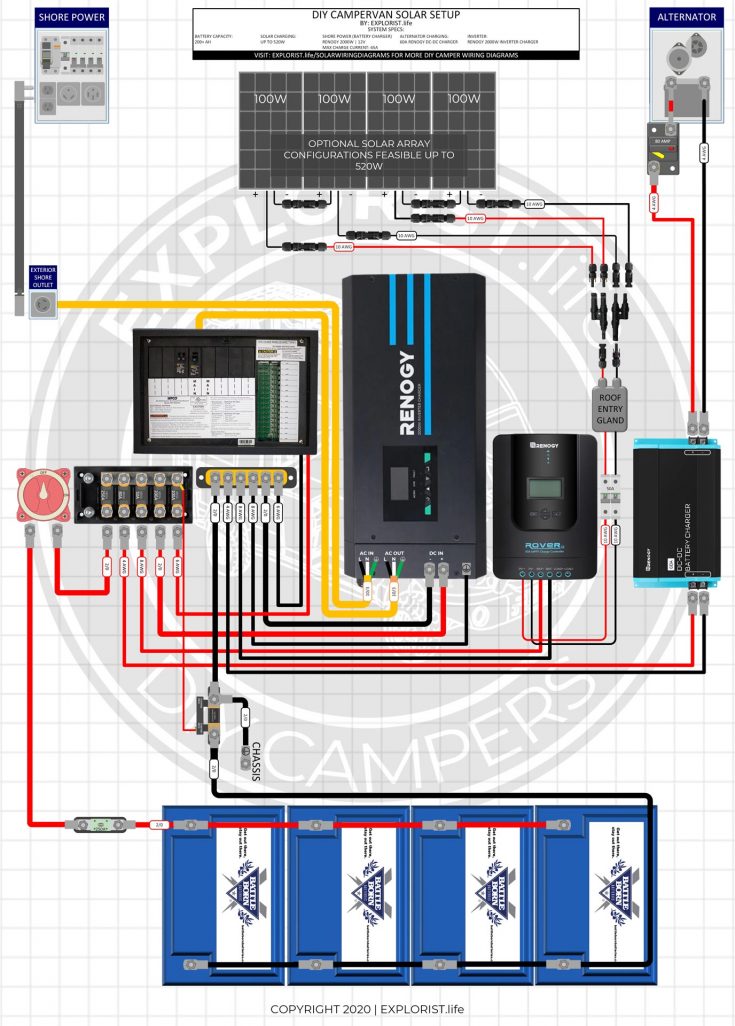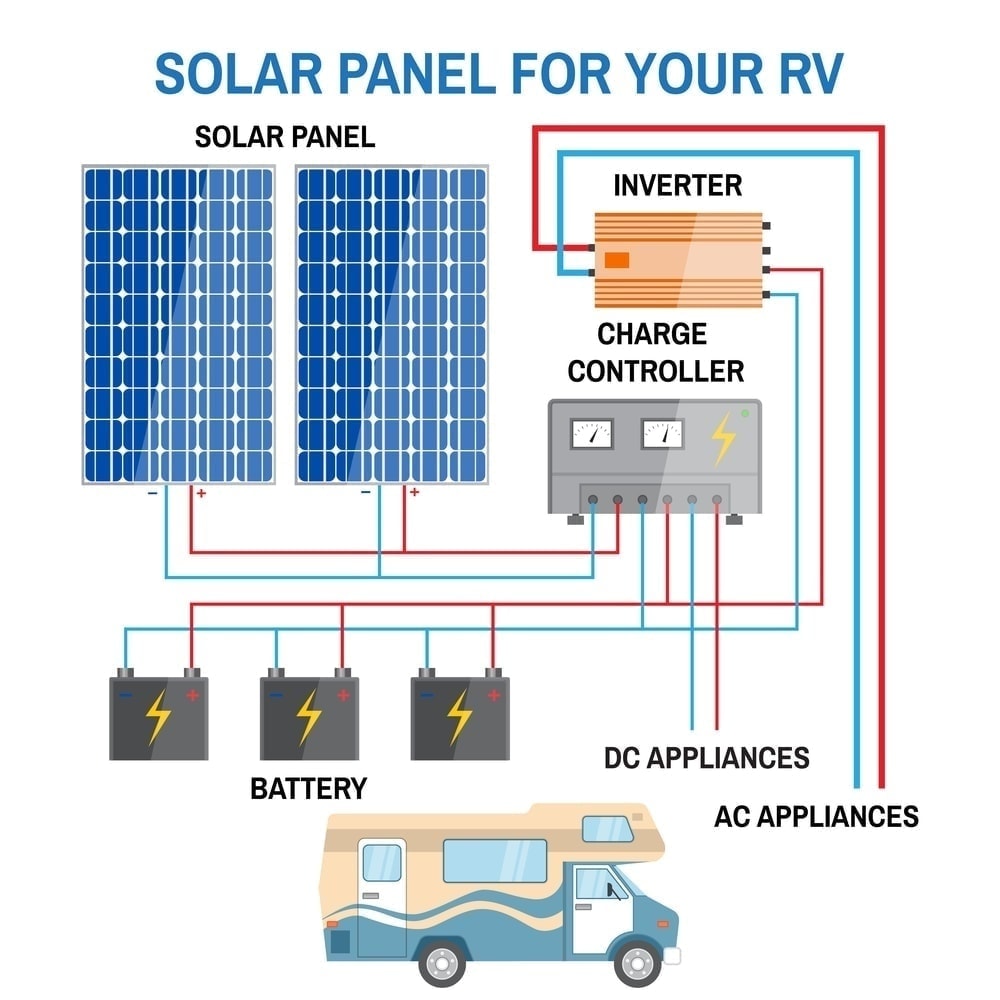“Off-grid camper solar wiring”
Understanding the Basics
Before we dive into the nitty-gritty of solar wiring, it’s essential to understand the fundamental principles of solar power and electrical systems. Solar panels convert sunlight into direct current (DC) electricity, which can be stored in batteries or used to power appliances directly. To use solar power efficiently, you’ll need to understand the following key concepts:
- Volts (V): The voltage of your solar panel system determines the amount of electrical pressure.
- Amps (A): The current of your system, measured in amps, indicates the flow rate of electrons.
- Watts (W): The power output of your system, calculated by multiplying volts and amps (V x A = W).
- Charge Controllers: These devices regulate the flow of energy from your solar panels to your batteries, preventing overcharging and ensuring safe, efficient charging.
- Inverters: These devices convert DC power from your batteries to alternating current (AC) power, allowing you to use standard appliances.
Components of an Off-Grid Camper Solar Wiring System

A typical off-grid camper solar wiring system consists of the following components:
- Solar Panels: These are the primary source of energy for your system, converting sunlight into DC electricity.
- Mounting Hardware: This includes the frames, clamps, and brackets that secure your solar panels to the camper’s roof or a ground-mounted array.
- Charge Controller: This device regulates the flow of energy from your solar panels to your batteries, ensuring safe and efficient charging.
- Batteries: Deep cycle batteries, such as lead-acid or lithium-ion, store excess energy generated by your solar panels for later use.
- Inverter/Charger: This device converts DC power from your batteries to AC power for appliances and can also charge your batteries from an external power source (e.g., a generator or shore power).
- Wiring and Connectors: These components connect your solar panels, charge controller, batteries, and inverter/charger, enabling the flow of energy throughout the system.
- Monitoring and Control Systems: Optional components, such as battery monitors and system controllers, help you track performance, optimize energy usage, and ensure system safety.


Designing Your Off-Grid Camper Solar Wiring System
To create an efficient and reliable solar wiring system, follow these steps:
- Determine Your Energy Needs: Calculate your daily energy requirements by considering factors like appliance usage, lighting, and charging devices.
- Select Your Solar Panel Array: Choose solar panels that meet your energy needs, taking into account factors like panel efficiency, size, and durability.
- Choose Your Battery Bank: Select deep cycle batteries that can store excess energy generated by your solar panels, considering factors like capacity, voltage, and chemistry (e.g., lead-acid or lithium-ion).
- Select Your Inverter/Charger: Choose an inverter/charger that can handle your system’s power requirements, considering factors like efficiency, surge capacity, and charging capabilities.
- Plan Your Wiring and Connectors: Design a wiring layout that minimizes energy losses and ensures safe, reliable connections between components.
- Consider Monitoring and Control Systems: Add optional components to track system performance, optimize energy usage, and ensure system safety.
Installation Best Practices
To ensure a safe and efficient installation, follow these best practices:
- Hire a Professional (If Needed): If you’re not experienced with electrical systems, consider hiring a professional to design and install your solar wiring system.
- Follow Manufacturer Instructions: Read and follow the manufacturer’s instructions for each component, ensuring proper installation and configuration.
- Use Proper Wiring and Connectors: Use high-quality, UV-resistant wiring and connectors to minimize energy losses and ensure reliable connections.
- Secure Components: Mount components securely to prevent damage from vibration, weather, or other external factors.
- Test and Inspect the System: Verify that your system is functioning correctly, checking for proper voltage, current, and power output.
Common Mistakes to Avoid
To avoid common mistakes that can compromise your solar wiring system’s performance and safety:
- Undersizing Your Solar Panel Array: Insufficient solar panel capacity can lead to inadequate energy generation, causing battery drain and system failure.
- Inadequate Battery Sizing: Insufficient battery capacity can cause deep discharging, reducing battery lifespan and system reliability.
- Poor Wiring and Connections: Inadequate or damaged wiring and connectors can lead to energy losses, overheating, and system failure.
- Inadequate Monitoring and Control: Failing to monitor system performance and control energy usage can result in inefficient energy use, reduced system lifespan, and safety hazards.
Conclusion
Off-grid camper solar wiring offers a reliable, renewable energy solution for camping enthusiasts. By understanding the basics, selecting the right components, and following best practices, you can design and install a solar-powered electrical system that meets your energy needs. Remember to avoid common mistakes, and consider hiring a professional if you’re unsure about any aspect of the installation. With the right system in place, you’ll be able to enjoy the freedom of off-grid camping, knowing that you have a reliable source of energy to power your adventures.
Additional Resources
For those interested in learning more about off-grid camper solar wiring, here are some additional resources:
- National Renewable Energy Laboratory (NREL): A comprehensive resource for renewable energy information, including solar power and energy storage.
- Solar Energy Industries Association (SEIA): A trade association that provides information on solar energy, including installation best practices and industry trends.
- Camper and RV forums: Online communities where you can connect with other campers and RV enthusiasts, sharing knowledge and experiences with off-grid solar wiring systems.
By following the guidelines and best practices outlined in this article, you’ll be well on your way to creating a reliable, efficient, and safe off-grid camper solar wiring system. Happy camping!






